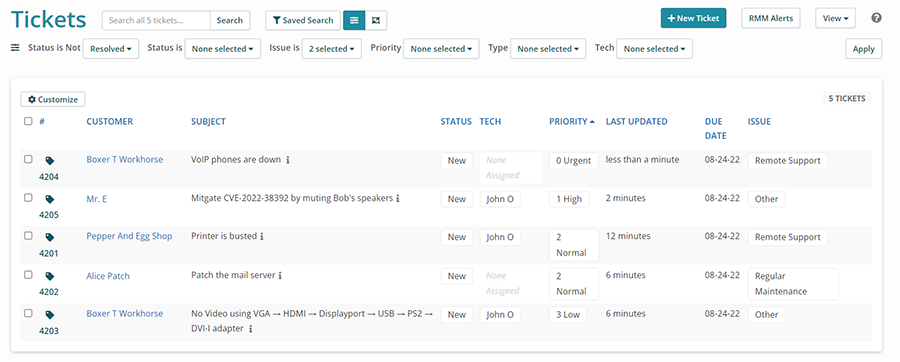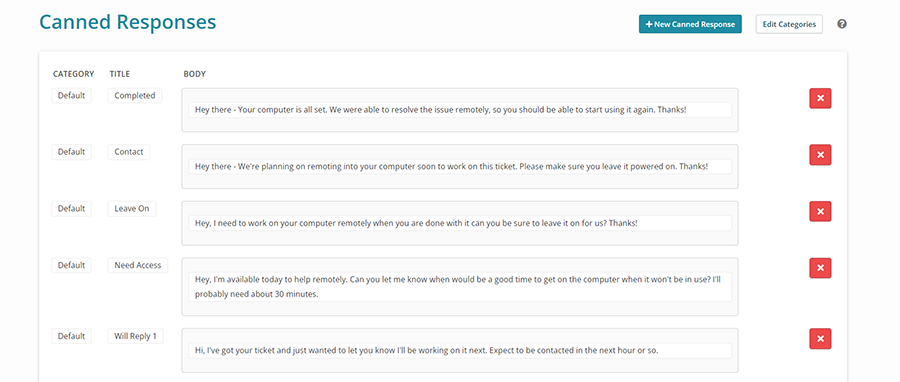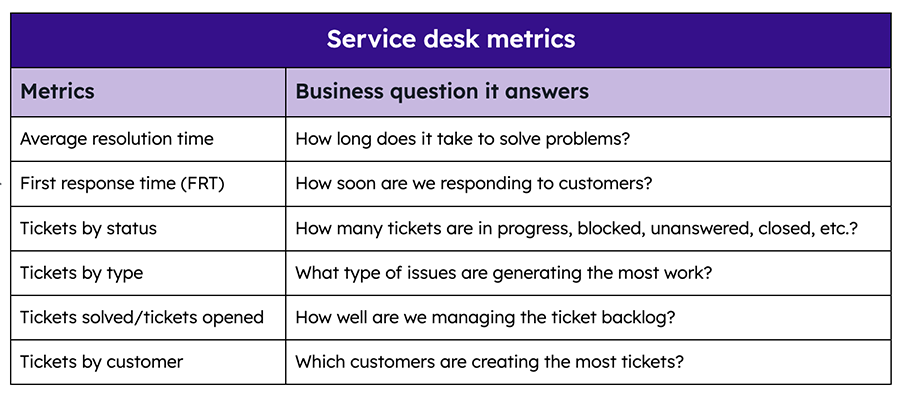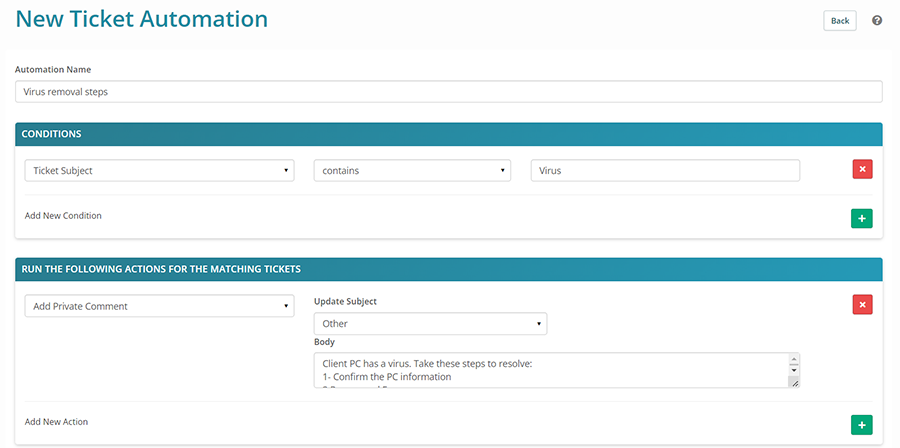For an MSP, a ticketing system is fundamental to delivering services and supporting clients. Every problem a client has or scheduled task exists as a ticket, and how the service desk triage and resolves those tickets can make or break an MSP over time.
Here, we’ll look at 12 practical ticket handling best practices you can use to ensure your MSP gets it right. While we won’t be able to solve the tickets for you (pro tip: it’s always DNS!), these best practices will help you take a practical approach to handling them more efficiently.
Why is ticket handling important to MSPs?
Tickets are the cornerstone of client interactions. If something breaks, it’s a ticket. If a server needs patching, it’s a ticket. If the client has a question, it’s a ticket. As a result, how MSPs handle tickets becomes a big part of the overall client experience.
Poor ticket handling practices can lead to breached SLAs, upset clients, and inefficient operations. Conversely, getting ticket handling right can improve client satisfaction, streamline operations, and grow the bottom line.
With the basics out of the way, let’s jump into 12 ticket handling best practices you can use to improve your operations and client service.
1. Make creating tickets painless for your clients
For you, tickets are a great way to prioritize and track work. For your clients, tickets are just a means to an end. They want you to fix something—“paperwork” is just a nuisance. If that nuisance creates too much friction, they’ll avoid it. That often leads to one of two outcomes:
1. No one creates tickets, and you do invisible work. You should avoid this case as much as practical. While it’s OK to let a 1-minute fix here or there go untracked, making untracked work the norm is an MSP antipattern.
2. You create the tickets for clients, leading to unnecessary extra work. It’s perfectly fine to create tickets for clients from time to time. In fact, that’s often the best customer service move you can make when a client raises an issue outside of the standard tech support channels. However, you don’t want your helpdesk bogged down with too much manual ticket creation.
The solution to both of these problems is to make ticket creation as painless as possible for your clients. Some of the most practical methods to improve the ticket creation process include:
- Creating tickets when a client emails the help desk.
- Limit the fields in ticket creation forms.
- Don’t fall into the habit of doing invisible work.
2. Define a prioritization strategy
Prioritization is one of the trickiest parts of triaging tickets. From the client’s perspective, most issues are a high priority. But you need a way to prioritize tickets to ensure the most urgent work gets done.
Frankly, there’s no single prioritization strategy that’s a universal fit. You’ll need to consider your customers, SLAs, and ticket category. The key is to take all that into context and define a prioritization strategy that works for your business. Ticketing systems that allow you to automatically update priority based on category or context can go a long way, but you still need to be purposeful with your approach.
What I’ve seen well in practice is a combination of first-in, first-out (FIFO), and business-specific prioritization criteria. For example, any network outages may be a high-priority ticket, but the high-priority queue itself is FIFO.

3. Use templates!
Template responses — a.k.a. canned responses — are one of the best ways to save time handling tickets. If you take nothing else away from our tips, let it be this: invest time getting your canned responses right. Create and maintain templates for common solutions, questions, and instructions you send to your clients.
Canned responses to common issues help you:
- Save time for you and your clients
- Ensure uniformity in your messaging
- Ask the right questions early in the troubleshooting process
- Support automation workflows
While I’m very bullish on templates in ticketing systems, sometimes MSPs do more harm than good with canned responses.
In these cases, it’s usually because they send clients irrelevant or stale information. Then they fall into a negative feedback loop. The issue doesn’t get solved. The client feels like they weren’t taken seriously and replies again. The helpdesk sends another template, and the cycle repeats with KPIs and customer satisfaction getting worse.
Fortunately, that cycle is easy to avoid if you keep template content up-to-date and allow support agents to use their discretion to modify canned responses.

4. Don’t be too noisy
Many ticketing systems send updates and auto-replies for activities like ticket creation and status changes. In the right context, that’s great. But it can also annoy or confuse users. If you’re leaving internal notes or making changes that don’t impact the client, ensure your system doesn’t flood them with emails.

5. One ticket, one topic
Users often raise multiple issues under a single ticket. From their perspective, it’s efficient. From the service desk’s perspective, it’s more difficult to track what work needs to be done. Make an effort to keep tickets dedicated to a single topic.
It’s OK if that topic is something broad like “patch all the servers at site A,” but avoid mixing unrelated items like security patches, monitor upgrades, and switch installs on a single ticket. Being disciplined about ticket topics will help you understand the status of any given issue faster and use cleaner data for reporting.
6. Track high-value metrics
Service desk metrics help you track how well you’re handling tickets today and where you should focus improvement efforts. Of course, it’s easy to get lost in all the metrics you could track, it’s harder to know which ones you should track.
![]()
Think about KPIs from the perspective of what questions you need to answer about your business. What is the service desk spending time on? How fast are we responding to tickets? Are we meeting our SLAs?
To help you get started, here are some key service desk performance metrics I recommend tracking.

7. Set up support tiers
As your service desk grows, you’ll quickly realize not all tickets are created equally. Some are simple issues you can solve in a minute. Others are complex problems that require research and technical expertise. You don’t want technical experts wasting time on the simple stuff. You also don’t want entry-level agents working on problems that are out of their depth.
The three-tier support system is a tried and true method for solving this problem. The three tiers, or levels, are:
- Tier 1: Front line support. Everything new comes into this team and gets escalated to another tier if necessary.
- Tier 2: Tech support. This team has more specialized skills and can handle issues Tier 1 can’t.
- Tier 3: Subject matter experts and senior support engineers. This team gets the most technical and complex issues the other tiers can’t handle.
8. Integrate ticketing with other systems
Tool sprawl is a major productivity killer for MSPs. Every new tool you have to manage and maintain is additional admin overhead. Additionally, data from one system might be relevant to another. Separate tools with siloed data lead to duplication and lower-quality reporting.
That’s why integrating your ticketing system with other core MSP tools like an RMM, wiki, billing, and asset management systems can be so powerful. With integrated systems, you have a one-stop shop with visibility into all of your relevant data and can create holistic workflows.
9. Group similar incidents for faster resolution
Often, a single event like a malware infection or power outage will lead to the creation of multiple similar tickets. When this happens, make sure to group or link the tickets so the technician that works one can complete them all at once.
Of course, if you’re using FIFO to manage queues, it can be difficult to know if an issue has generated multiple tickets until you’ve already handled them. In those cases, the key is for service desk agents to be diligent about recognizing a pattern early. Once you handle a few tickets with a similar pattern, stop and check the queues to see how widespread the problem is. Additionally, tracking the number of created tickets and their status can help you detect and investigate spikes caused by a single incident.
10. Automate, automate, automate
A lot of service desk work is repetitive. That means a lot of service desk work can be automated. Any time you find you’re regularly performing the same steps to resolve the same issue, look for a way to automate the task. You’re probably used to this way of thinking about RMMs, but it applies to tickets too.
For example, if a specific ticket subject like “virus detected” always leads to your service desk following the same steps, display your virus removal checklist every time. Similarly, if specific tickets need to be assigned to specific technicians, automate the assignment.

11. Document concisely
Recording quality notes is one of the most essential ticket handling best practices. Good notes make it easier to explain work to a client, hand a ticket off to another engineer, and understand ticket history. Bad (or missing) notes lead to confusion, finger pointing, and duplication of efforts.
Despite most MSPs knowing this already, many still struggle with poor ticket notes. These tips can help ensure technicians take quality notes:
- Be complete but concise: Technicians shouldn’t feel like they need to write a book to complete a ticket. Encourage concise writing (e.g., bullet point summaries) that cover just enough to provide their work’s technical and business context.
- Provide feedback on notes: One of the reasons it’s easy for note quality to suffer is that notes are easy to overlook. Set aside time to review note quality in your ticketing management system, and provide feedback to your techs.
- Make documentation part of the definition of done: Make sure your team knows notes are a requirement before closing a ticket.
- Provide examples of good documentation: “Good” notes are subjective. To avoid ambiguity, provide technicians with examples that make expectations clear.
12. Track your time
For MSPs, time is quite literally money. Time spent working on a ticket is at least labor cost and often billable hours. Directly tracking your time on specific tickets allows you to track costs and bill your clients accurately.
This is where a tightly integrated ticketing management system and RMM can make a major difference. For example, with Syncro, technicians can simply start a timer on a ticket to track billable hours.
Ready to experience ticket management the Syncro way?
Syncro’s all-in-one PSA and RMM has everything you need for effective ticket management. Enjoy customizable ticket workflows, templated worksheets, integrated billing, and more.
Try Syncro for yourself—start a free trial today.


)